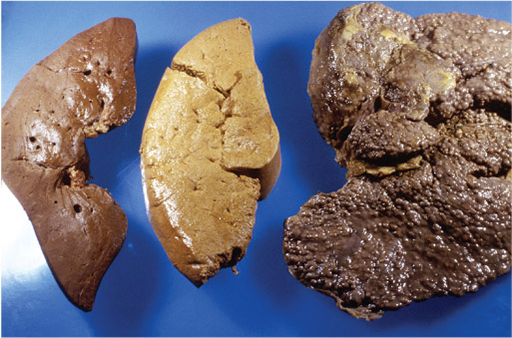2.1.1 Alcoholic liver disease (ALD)
With the exception of the brain, the liver is perhaps the most complex organ in the body, carrying out a wide range of essential body functions.
Describe one function of the liver that you have learned about earlier in the course.
In the context of this course, you know that the liver is where the body metabolises alcohol. It also carries out a great many other processes, including removing toxic chemicals and metabolising drugs. The liver also makes hormones and proteins important for blood clotting and other functions.
The liver is very resilient and is capable of regenerating itself by replacing damaged cells. But excessive alcohol use over many years can reduce regeneration, resulting in serious damage to the liver. The liver receives three-quarters of its blood supply from the portal vein which carries blood directly from the gut, complete with nutrients and other dissolved substances (alcohol, toxins, drugs etc). This means that the liver is exposed to high concentrations of alcohol and therefore is very susceptible to alcohol-related damage.
It is therefore perhaps unsurprising that the best-known harmful long-term side effect of drinking excessive alcohol is damage to the liver in the form of alcoholic liver disease (ALD), as illustrated in Figure 4.

Alcoholic liver disease is categorised into three progressive stages of increasing severity: fatty liver, hepatitis and cirrhosis.
The first stage of ALD, fatty liver, is an early and reversible consequence of excessive alcohol consumption, during which fat accumulates within the cells of the liver. Fatty liver in itself does not cause long-term damage to the liver and can be reversed by abstaining from drinking alcohol. However, it can be an important early indication that harm is being done and that continued excessive alcohol consumption could lead to the more serious conditions of hepatitis and cirrhosis.
Hepatitis means ‘inflammation of the liver’ and can range from mild – only detectable through blood tests – to severe, causing nausea and vomiting, jaundice (yellowing of the skin) and pain. Hepatitis is also reversible if an individual stops consuming alcohol. However, very severe hepatitis can lead to liver failure which is often fatal.
In the third stage, cirrhosis, liver cells are gradually and irreversibly replaced by scar tissue. This occurs in about 10% of chronic heavy drinkers. Not only does this decrease the ability of the liver to perform its many essential biological functions, it also disrupts the blood flow through the liver tissue. This in turn causes serious complications such as damage to the spleen (an organ involved in blood maintenance) and the circulatory system of the gut (as blood pressure increases in the portal vein because the blood flows more slowly through the liver).
